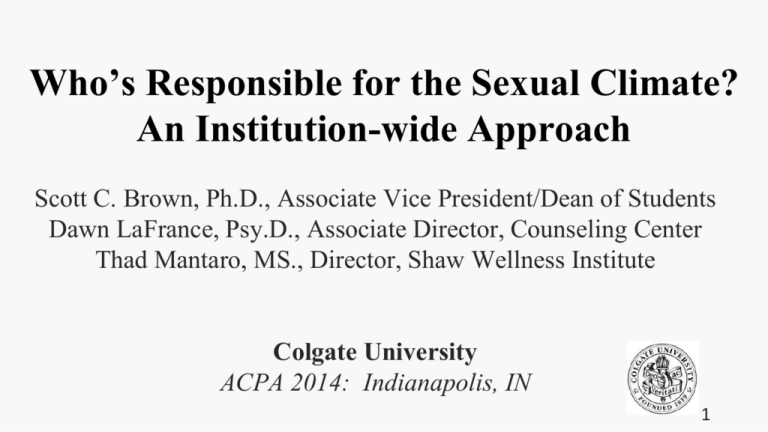
Who’s Responsible for the Sexual Climate?
An Institution-wide Approach
Scott C. Brown, Ph.D., Associate Vice President/Dean of Students
Dawn LaFrance, Psy.D., Associate Director, Counseling Center
Thad Mantaro, MS., Director, Shaw Wellness Institute
Colgate University
ACPA 2014: Indianapolis, IN
1
Context
• The social and sexual climate is a central issue for
college students.
• Students desire to navigate their sexuality in a safe
and constructive environment.
• Students report sexual assaults and harassment.
• Institutions are expected to be proactive.
• How can we create a climate of sexual respect?
2
Learning Objectives
• Increased knowledge of an all-campus approach to
improve sexual climate.
• List 3-5 programs and initiatives that support a
positive sexuality model.
• Identify at least 3 initiatives to consider on your
campus.
• “Wise people learn from their mistakes…”
3
Agenda
Legal and Political Landscape
Sexual Climate Advisory Committee (SCAC)
“Plan Do Study Act” Approach
Positive Sexuality Initiatives
Translating Strategies to other Campuses
Questions/Closing/Evaluation
4
Legal and Political Landscape
• Know Your IX
• University of Montana “Blueprint”
• Campus SAVE Act
• Dear Colleague Letter 2011
5
Legal and Political Landscape
• Obama White
House Action
(2014)
Video goes here
http://www.whitehouse.gov/the-press-office/2014/01/24/weekly-address-taking-actionend-sexual-assault
6
Sexual Climate Advisory Committee (SCAC)
Setting the Stage
Colgate University – Size, Location, Campus Culture
Your Stakeholders – Interest & Motivation
Consider Current Data Points
Set Realistic Goals
7
Sexual Climate Advisory Committee (SCAC)
Charge
“Faculty, staff and students are charged with
developing, coordinating, and evaluating initiatives
that improve the sexual climate.”
“All that rises must converge.”
8
Sexual Climate Advisory Committee
S.M.A.R.T. Goal
“Using a PDSA approach, improve the sexual climate as
evidenced by reduction in students taken advantage of
sexually, experienced attempted/successful
penetration, and sexual harassment; and increase in
percentage of students who can define consent and
perceive themselves empowered to make own sexual
choices.”
9
Sexual Climate Advisory Committee
10
11
Sexual Climate Advisory Committee
Inclusive, comprehensive, dynamic and nimble
Faculty, students, staff (representative)
Approach/Sub-Committees
o
Individual (Health/Education)
o
Environment (Programming/Events)
o
System (Policy)
12
Sexual Climate Advisory Committee
Monthly Agenda Template
Update on PDSAs in progress/data review
(attendance/demos, pre-post, focus groups, quick
polls, etc.)
Proposed new area-related initiatives/PDSAs
Suggestions for monthly surveys
Possible topics for full SCAC discussion
Sexual Climate Advisory Committee
Individual
•
Yes Means Yes
•
YMY 2.0
Video goes here
14
Sexual Climate Advisory Committee
Individual
•
Womentoring program (discontinued)
•
Train Deans-on-Call to interface with all
stakeholders on victim’s behalf
•
Random Conversations About Sex (RUCAS)
15
Sexual Climate Advisory Committee
Environment
Lectures
Laci Green “Best Sex Ever”
Naomi Wolf
Jackson Katz
Queerfest
Performances
“This is Not a Play
about Sex”
Vagina Monologues
“Wires” and FUSE
Dance
16
Sexual Climate Advisory Committee
Environment
Communication
Trainings
Pos. Sexuality Website
Pos. Sexuality Calendar
Educational Campaigns
Peer Health Educators
Workshop Series (e.g.,
Greek, Student
Government)
17
Sexual Climate Advisory Committee
Environment
Groups
Summit
Feminist Council of Elders
• Sexual Climate Summit
Positive Sexuality House
Bystander Intervention
Focus Groups (e.g., Taxonomy
of Sexual Situations, NonMajority Population)
18
Sexual Climate Advisory Committee
System
Training
First responders (RAs,
Campus Safety, Deans)
Equity Grievance Panel
(EGP)/appellate officers
Teaching sexual
violence issues
Policy and Procedures
First-year orientation
Student of concern forms
Brown bags/brochures
Audit EGP Process &
Sexual Climate
19
Sexual Climate Advisory Committee
System
Communication
•
Nine for IX
•
Assessing Incapacity
•
SCAC Awareness
•
Consent
20
Sexual Climate Advisory Committee
System - Communication
21
Sexual Climate Advisory Committee
Results
• We saw in increase of 41.7% in the number of students who could
correctly identify consent after the campaign.
100%
85%
80%
60%
60%
Pre-campaign
Post-campaign
40%
20%
0%
Correctly Identified
Consent
Sexual Climate Advisory Committee
Results (continued)
# of Events Participants
Total Programming: 37
2875
EGP Policy/Training: 7
963
Total:
3908
45
Translation to Other Campuses
Make the case: Legal, educational, aspirational
Stakeholder: Who cares and/or can get things done?
Communicate, Coordinate, Cultivate
Three things you might do?
Comments?
24
Thank You!
Contact
Scott Brown: sbrown@colgate.edu
Dawn LaFrance: dlafrance@colgate.edu
Thad Mantaro: tmantaro@colgate.edu
References
•
Baxter Magolda, M., & King, P. (2004). Learning Partnerships: Theory and models of practice to
educate for self-authorship. Sterling VA: Stylus.
•
Bogle, K. A. (2008). Hooking up: Sex, dating, and relationships on campus. New York University
Press: New York.
•
Breitenbecher, K. H. (2000). Sexual assault on college campuses: Is an ounce of prevention enough?
Applied and Preventive Psychology, 9, 23-52.
•
DeFur, K. M. (2012). Don't Forget the Good Stuff! Incorporating Positive Messages of Sexual
Pleasure into Sexuality. American Journal of Sexuality Education, 7(2), 160-169.
•
DeKeseredy, W. S., & Kelly, K. (1993). The incidence and prevalence of woman abuse in Canadian
university and college dating relationships. Canadian Journal of Sociology, 18, 137-159.
26
References
•
Foubert, J. D., & Newberry, J. T. (2006). Effects of two versions of an empathy-based rape
prevention program on fraternity men's survivor empathy, attitudes, and behavioral intent to commit
rape or sexual assault. Journal of College Student Development, 47, 133-148.
•
Friedman, J. and Valenti, J. (2008). Yes Means Yes! Visions of Female Sexual Power and a World
Without Rape. Seal Press: Berkeley, CA.
•
Katz, J. (1994). Mentors in Violence Prevention (MVP) trainer’s guide. Northeastern University’s
Center for the Study of Sport in Society. Boston, MA.
•
LaFrance, D. F., Loe, M., & Brown, S. C. (2012). “Yes Means Yes”: A new approach to sexual
assault prevention. American Journal of Sexuality Education, 7, 445-460.
•
Oswalt, S.B. (2010). Beyond risk: Examining college students' sexual decision-making. American
Journal of Sexuality Education, 5(3), 217-239.
•
Owen, J. J., Rhoades, G. K., Stanley, S. M., & Fincham, F. D. (2008). “Hooking up” among college
students: Demographic and psychological correlates. Archives of Sexual Behavior, 39, 653-663.
27







